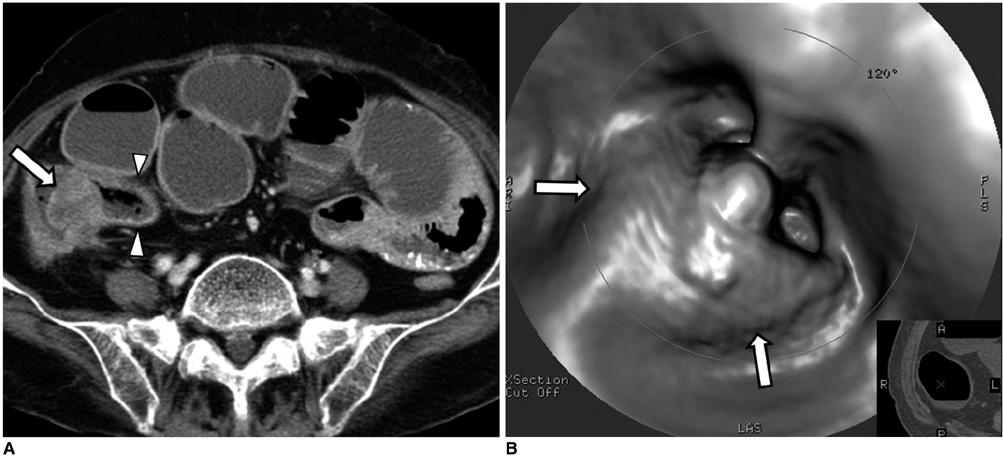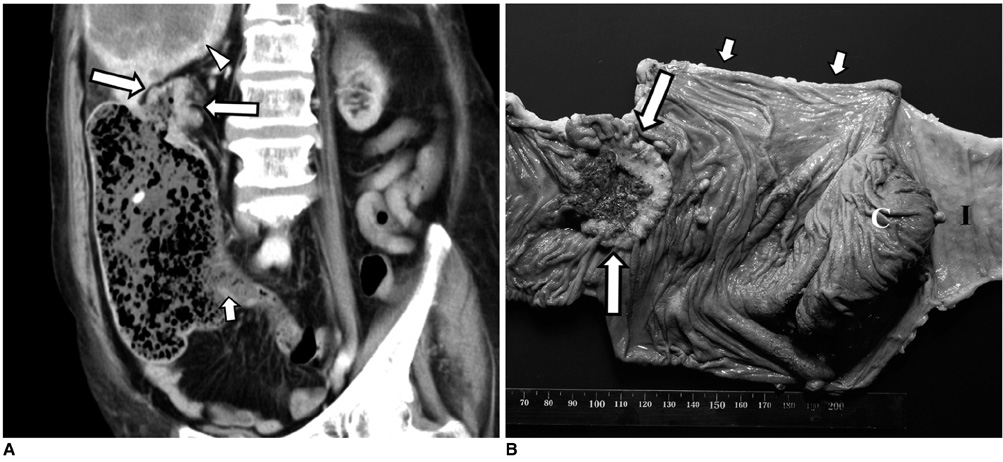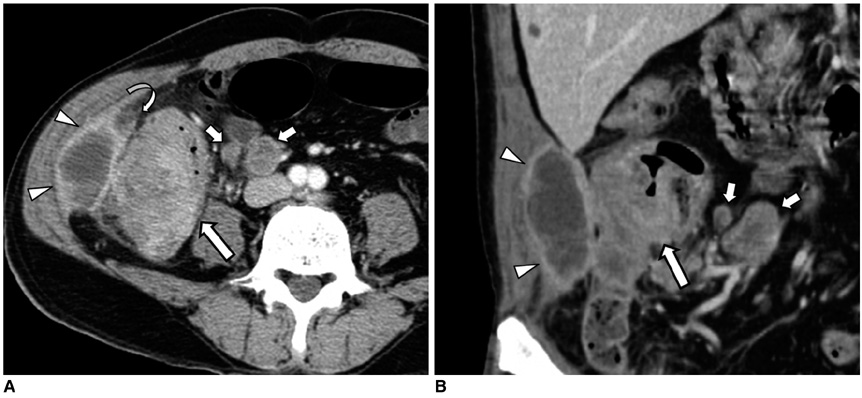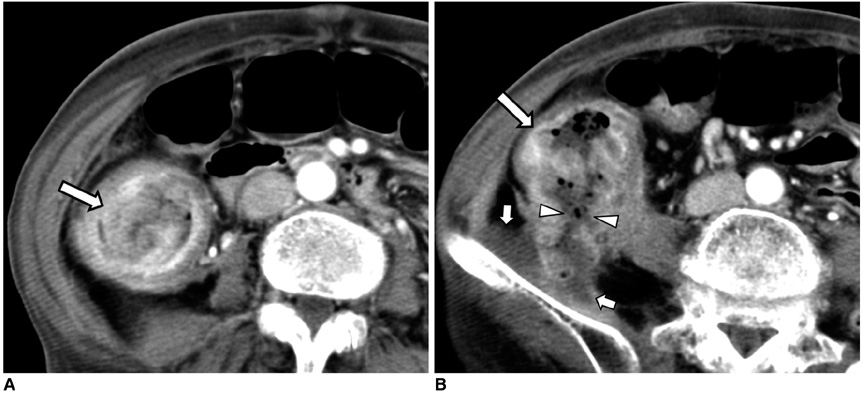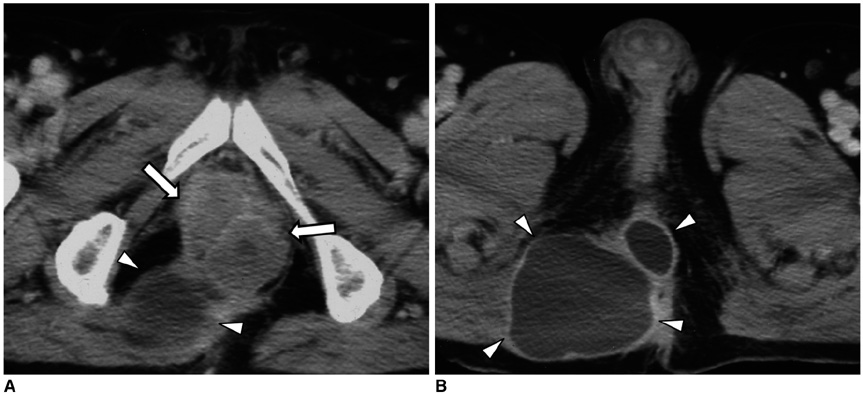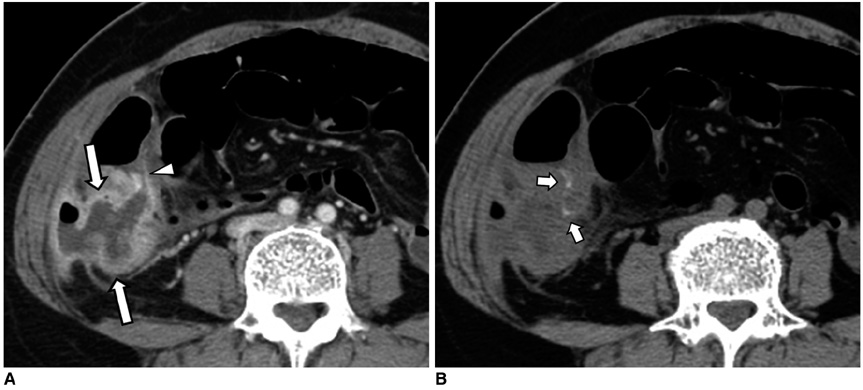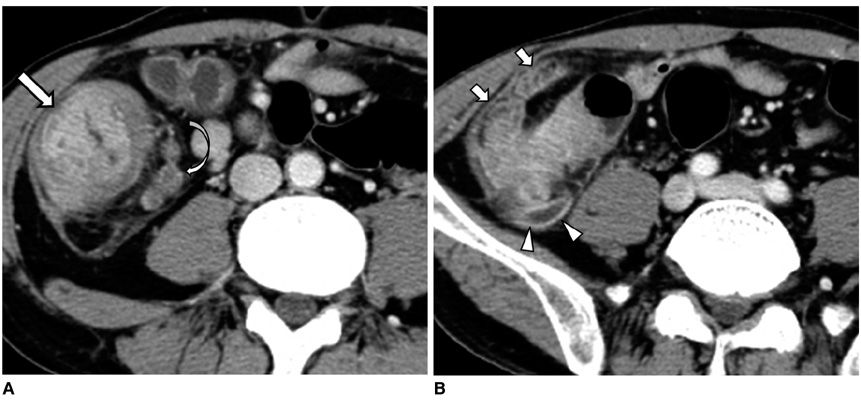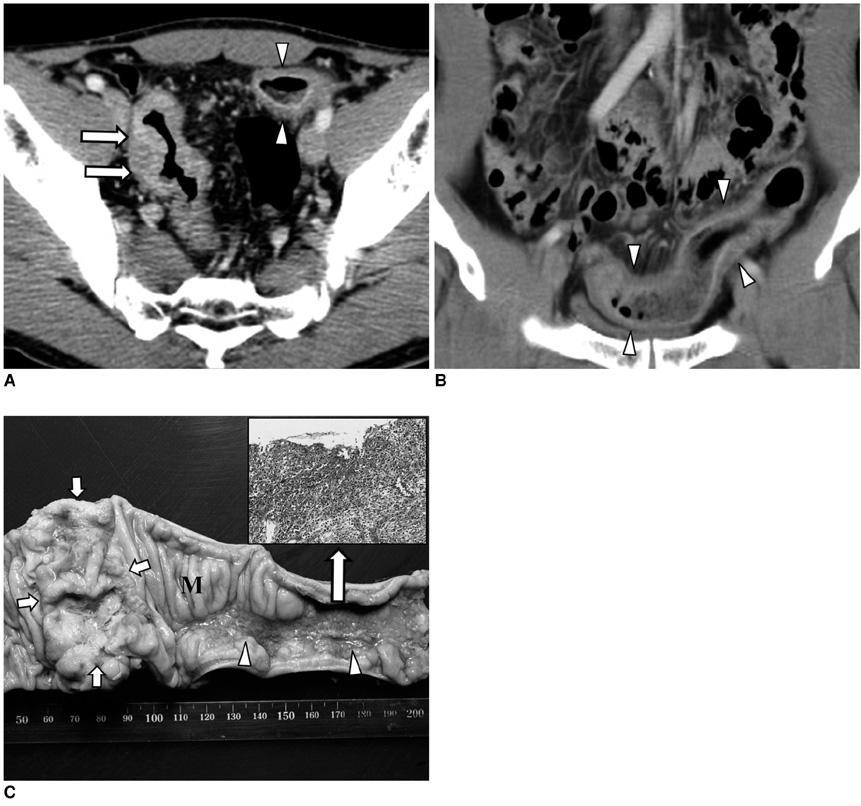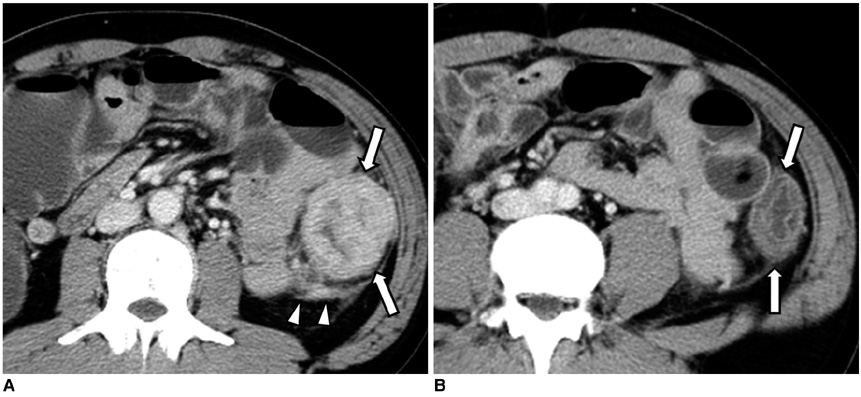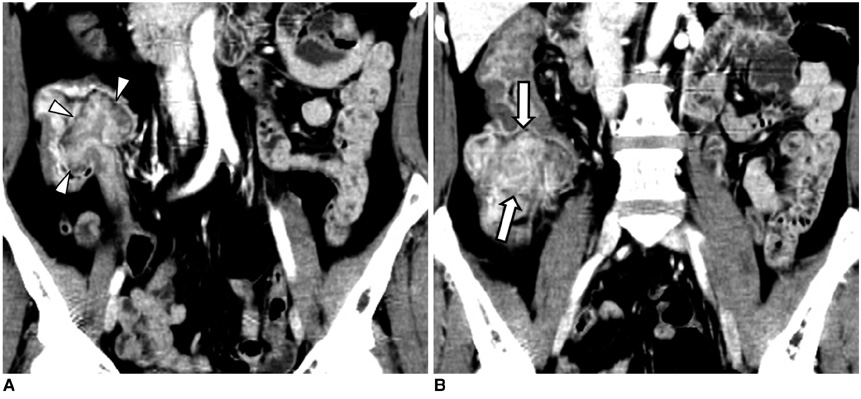Korean J Radiol.
2010 Apr;11(2):211-221. 10.3348/kjr.2010.11.2.211.
CT Findings of Colonic Complications Associated with Colon Cancer
- Affiliations
-
- 1Department of Radiology, Cheonan Hospital, Soonchunhyang University, Cheonan 330-720, Korea. rad2000@hanmail.net
- 2Department of Pathology, Cheonan Hospital, Soonchunhyang University, Cheonan 330-720, Korea.
- KMID: 1783198
- DOI: http://doi.org/10.3348/kjr.2010.11.2.211
Abstract
- A broad spectrum of colonic complications can occur in patients with colon cancer. Clinically, some of these complications can obscure the presence of underlying malignancies in the colon and these complications may require emergency surgical management. The complications of the colon that can be associated with colon cancer include obstruction, perforation, abscess formation, acute appendicitis, ischemic colitis and intussusception. Although the majority of these complications only rarely occur, familiarity with the various manifestations of colon cancer complications will facilitate making an accurate diagnosis and administering prompt management in these situations. The purpose of this pictorial essay is to review the CT appearance of the colonic complications associated with colon cancer.
MeSH Terms
-
Abdominal Abscess/complications/radiography
Adult
Aged
Aged, 80 and over
Appendicitis/complications/radiography
Colitis, Ischemic/complications/radiography
Colon/*radiography
Colonic Diseases/complications/radiography
Colonic Neoplasms/*complications/*radiography
Female
Humans
Intestinal Diseases/*complications/*radiography
Intestinal Obstruction/complications/radiography
Intussusception/complications/radiography
Male
Middle Aged
Tomography, X-Ray Computed/*methods
Figure
Reference
-
1. Horton KM, Abrams RA, Fishman EK. Spiral CT of colon cancer: imaging features and role in management. Radiographics. 2000. 20:419–430.2. Filippone A, Ambrosini R, Fuschi M, Marinelli T, Genovesi D, Bonomo L. Preoperative T and N staging of colorectal cancer: accuracy of contrast-enhanced multi-detector row CT colonography--initial experience. Radiology. 2004. 231:83–90.3. Biondo S, Kreisler E, Millan M, Fraccalvieri D, Golda T, Marti Rague J, et al. Differences in patient postoperative and long-term outcomes between obstructive and perforated colonic cancer. Am J Surg. 2008. 195:427–432.4. Hoeffel C, Crema MD, Belkacem A, Azizi L, Lewin M, Arrive L, et al. Multi-detector row CT: spectrum of diseases involving the ileocecal area. Radiographics. 2006. 26:1373–1390.5. Rovito PF, Verazin G, Prorok JJ. Obstructing carcinoma of the cecum. J Surg Oncol. 1990. 45:177–179.6. Balthazar EJ, Birnbaum BA, Megibow AJ, Gordon RB, Whelan CA, Hulnick DH. Closed-loop and strangulating intestinal obstruction: CT signs. Radiology. 1992. 185:769–775.7. McKay A, Bathe OF. A novel technique to relieve a closed-loop obstruction secondary to a competent ileocecal valve and an unresectable mid-colon tumor. J Gastrointest Surg. 2007. 11:1365–1367.8. Hulnick DH, Megibow AJ, Balthazar EJ, Gordon RB, Surapenini R, Bosniak MA. Perforated colorectal neoplasms: correlation of clinical, contrast enema, and CT examinations. Radiology. 1987. 164:611–615.9. Tsai HL, Hsieh JS, Yu FJ, Wu DC, Chen FM, Huang CJ, et al. Perforated colonic cancer presenting as intra-abdominal abscess. Int J Colorectal Dis. 2007. 22:15–19.10. Kim SH, Shin SS, Jeong YY, Heo SH, Kim JW, Kang HK. Gastrointestinal tract perforation: MDCT findings according to the perforation sites. Korean J Radiol. 2009. 10:63–70.11. Okita A, Kubo Y, Tanada M, Kurita A, Takashima S. Unusual abscesses associated with colon cancer: report of three cases. Acta Med Okayama. 2007. 61:107–113.12. Matsumoto G, Asano H, Kato E, Matsuno S. Transverse colonic cancer presenting as an anterior abdominal wall abscess: report of a case. Surg Today. 2001. 31:166–169.13. Tsukuda K, Ikeda E, Miyake T, Ishihara Y, Watatani H, Nogami T, et al. Abdominal wall and thigh abscess resulting from the penetration of ascending colon cancer. Acta Med Okayama. 2005. 59:281–283.14. Pereira JM, Sirlin CB, Pinto PS, Jeffrey RB, Stella DL, Casola G. Disproportionate fat stranding: a helpful CT sign in patients with acute abdominal pain. Radiographics. 2004. 24:703–715.15. Arjona Sanchez A, Tordera Torres EM, Cecilia Martinez D, Rufian Pena S. Colon cancer presenting as an appendiceal abscess in a young patient. Can J Surg. 2008. 51:E15–E16.16. Rao PM, Rhea JT, Novelline RA, McCabe CJ, Lawrason JN, Berger DL, et al. Helical CT technique for the diagnosis of appendicitis: prospective evaluation of a focused appendix CT examination. Radiology. 1997. 202:139–144.17. Ko GY, Ha HK, Lee HJ, Jeong YK, Kim PN, Lee MG, et al. Usefulness of CT in patients with ischemic colitis proximal to colonic cancer. AJR Am J Roentgenol. 1997. 168:951–956.18. Xiong L, Chintapalli KN, Dodd GD 3rd, Chopra S, Pastrano JA, Hill C, et al. Frequency and CT patterns of bowel wall thickening proximal to cancer of the colon. AJR Am J Roentgenol. 2004. 182:905–909.19. Jang HJ, Lim HK, Park CK, Kim SH, Park JM, Choi YL. Segmental wall thickening in the colonic loop distal to colonic carcinoma at CT: importance and histopathologic correlation. Radiology. 2000. 216:712–717.20. Kim YH, Blake MA, Harisinghani MG, Archer-Arroyo K, Hahn PF, Pitman MB, et al. Adult intestinal intussusception: CT appearances and identification of a causative lead point. Radiographics. 2006. 26:733–744.21. Tresoldi S, Kim YH, Blake MA, Harisinghani MG, Hahn PF, Baker SP, et al. Adult intestinal intussusception: can abdominal MDCT distinguish an intussusception caused by a lead point? Abdom Imaging. 2008. 33:582–588.
- Full Text Links
- Actions
-
Cited
- CITED
-
- Close
- Share
- Similar articles
-
- The Association of Anisakiasis in the Ascending Colon with Sigmoid Colon Cancer: CT Colonography Findings
- Diagnostic Value of Computed Tomography in the Colon Cancer: In Terms of the Staging System
- Imaging Analysis of Colonic Villous Tumors
- CT Findings of Non-specific Colonic Edema in Liver Cirrhosis
- A Case of Inserting Two Self-expandable Metal Stents in Dual Malignant Colonic Obstructions

